The Temporal and Spatial Distributions of the Near-Surface CO2 Concentrations in Central Asia and Analysis of Their Controlling Factors
Abstract
:1. Introduction
2. Materials and Methods
2.1. Research Area
2.2. Date and Methodology
3. Results
3.1. Ground-Based Validation of the GOSAT CO2 Product
3.2. The Temporal and Spatial Distributions of the Near-Surface CO2 Concentrations in Central Asia
4. Discussion
4.1. Factors Affecting the Temporal Distribution of CO2 Concentrations in Central Asia
4.2. Factors Affecting the Spatial Distribution of CO2 Concentrations in Central Asia
5. Conclusions
- (1)
- The near-surface CO2 product inverted from the GOSAT data is strongly correlated with data from the nine stations that surround Central Asia. The correlation coefficients are all higher than 0.7, and the mean monthly deviation is less than 2 ppmv. The GOSAT results are highly accurate and stable and can be used to capture the seasonal and annual variations of near-surface CO2.
- (2)
- The near-surface CO2 concentrations in Central Asia are regionally heterogeneous. CO2 concentrations in the western arid region are higher than those in the east. The near-surface CO2 concentrations are lower in high altitude areas, namely, in the Altai Mountains, Tianshan Mountains, Pamir Plateau, and Kunlun Mountains.
- (3)
- The near-surface CO2 concentrations in Central Asia have an annual increasing trend. The annual mean rate of increase is 2.207 ppmv/a. The near-surface CO2 concentrations of each season increase compared with the preceding years. The near-surface CO2 concentrations of each month are higher than those of the corresponding months of the previous year in Central Asia. The near-surface CO2 concentrations have seasonal and monthly cycles.
- (4)
- The temporal variations of the near-surface CO2 concentrations in Central Asia are mainly affected by the photosynthesis/respiration of the continental ecosystem and heating. The controlling factors are different during the different seasons. Due to the topography and the prevailing winds, the spatial distribution of the CO2 concentrations in the five Central Asian countries is mainly affected by the CO2 emissions from surrounding countries. Due to the gradual decrease in the diffusion of CO2, the central, eastern, and southeastern regions of the five Central Asian countries are significantly affected by the NPP. At the national scale, the near-surface CO2 concentrations of the five Central Asian countries are not significantly related to energy consumption. Due to the topography, the CO2 concentrations in Xinjiang are not significantly affected by the diffusion of CO2 from outside regions; the spatial heterogeneity is mainly affected by energy consumption and the prevailing winds, and the NPP has an insignificant effect on the CO2 concentrations.
Acknowledgments
Author Contributions
Conflicts of Interest
References
- Bindoff, N.L.; Stott, P.A.; AchutaRao, K.M.; Allen, M.R.; Gillett, N.; Gutzler, D.; Hansingo, K.; Hegerl, G.; Hu, Y.; Jain, S.; et al. Detection and attribution of climate change: From global to regional. In Climate Change 2013: The Physical Science Basis. Contribution of Working Group I to the Fifth Assessment Report of the Intergovernmental Panel on Climate Change; Stocker, T.F., Qin, D., Plattner, G.-K., Tignor, M., Allen, S.K., Boschung, J., Nauels, A., Xia, Y., Bex, V., Midgley, P.M., Eds.; Cambridge University Press: Cambridge, UK; New York, NY, USA, 2013; pp. 867–952. ISBN 978-1-107-05799-1. [Google Scholar]
- Shaw, M.R.; Zavaleta, E.S.; Chiariello, N.R.; Cleland, E.E.; Mooney, H.A.; Field, C.B. Grassland responses to global environmental changes suppressed by elevated CO2. Science 2002, 298, 1987–1990. [Google Scholar] [CrossRef] [PubMed]
- Zeng, N.; Zhao, F.; Collatz, G.J.; Kalnay, E.; Salawitch, R.J.; West, T.O.; Guanter, L. Agricultural green revolution as a driver of increasing atmospheric CO2 seasonal amplitude. Nature 2014, 515, 394–397. [Google Scholar] [CrossRef] [PubMed]
- Graham, E.A.; Nobel, P.S. Long-term effects of a doubled atmospheric CO2 concentration on the cam species agave deserti. J. Exp. Bot. 1996, 47, 61–69. [Google Scholar] [CrossRef]
- Hamerlynck, E.P.; Huxman, T.E.; Charlet, T.N.; Smith, S.D. Effects of elevated CO2 (FACE) on the functional ecology of the drought-deciduous Mojave Desert shrub, Lycium andersonii. Environ. Exp. Bot. 2002, 48, 93–106. [Google Scholar] [CrossRef]
- Leakey, A.D.B.; Uribelarrea, M.; Ainsworth, E.A.; Naidu, S.L.; Rogers, A.; Ort, D.R.; Long, S.P. Photosynthesis, productivity, and yield of maize are not affected by open-air elevation of CO2 concentration in the absence of drought. Plant Physiol. 2006, 140, 779–790. [Google Scholar] [CrossRef] [PubMed]
- Lessin, R.C.; Ghini, R. Effect of increased atmospheric CO2 concentration on powdery mildew and growth of soybean plants. Trop. Plant. Pathol. 2009, 34, 385–392. [Google Scholar] [CrossRef]
- Li, C.F.; Zhang, C.; Luo, G.P.; Chen, X. Modeling the carbon dynamics of the dryland ecosystems in Xinjiang, China from 1981 to 2007—The spatiotemporal patterns and climate controls. Ecol. Model. 2013, 267, 148–157. [Google Scholar] [CrossRef]
- Butz, A.; Hasekamp, O.P.; Frankenberg, C.; Aben, I. Retrievals of atmospheric CO2 from simulated space-borne measurements of backscattered near-infrared sunlight: Accounting for aerosol effects. Appl. Opt. 2009, 48, 3322–3336. [Google Scholar] [CrossRef] [PubMed]
- Feng, L.; Palmer, P.I.; Bösch, H.; Dance, S. Estimating surface CO2 fluxes from space-borne CO2 dry air mole fraction observations using an ensemble kalman filter. Atmos. Chem. Phys. 2009, 9, 2619–2633. [Google Scholar] [CrossRef]
- Nevison, C.D.; Mahowald, N.M.; Doney, S.C.; Lima, I.D.; Van der Werf, G.R.; Randerson, J.T.; Baker, D.F.; Kasibhatla, P.; McKinley, G.A. Contribution of ocean, fossil fuel, land biosphere, and biomass burning carbon fluxes to seasonal and interannual variability in atmospheric CO2. J. Geophys. Res. Biogeosci. 2008. [Google Scholar] [CrossRef]
- O’Dell, C.W.; Connor, B.; Bösch, H.; O’Brien, D.; Frankenberg, C.; Castano, R.; Christi, M.; Eldering, D.; Fisher, B.; Gunson, M.; et al. The ACOS CO2 retrieval algorithm—Part 1: Description and validation against synthetic observations. Atmos. Meas. Tech. 2012, 5, 99–121. [Google Scholar] [CrossRef]
- Reuter, M.; Buchwitz, M.; Schneising, O.; Heymann, J.; Bovensmann, H.; Burrows, J.P. A method for improved SCIAMACHY CO2 retrieval in the presence of optically thin clouds. Atmos. Meas. Tech. 2010, 3, 209–232. [Google Scholar] [CrossRef]
- Baker, D.F.; Bosch, H.; Doney, S.C.; O’Brien, D.; Schimel, D.S. Carbon source/sink information provided by column CO2 measurements from the Orbiting Carbon Observatory. Atmos. Chem. Phys. 2010, 10, 4145–4165. [Google Scholar] [CrossRef]
- Schneising, O.; Buchwitz, M.; Reuter, M.; Heymann, J.; Bovensmann, H.; Burrows, J.P. Long-term analysis of carbon dioxide and methane column-averaged mole fractions retrieved from SCIAMACHY. Atmos. Chem. Phys. 2011, 11, 2863–2880. [Google Scholar] [CrossRef]
- Aumann, H.H.; Gregorich, D.; Gaiser, S. AIRS hyper-spectral measurements for climate research: Carbon dioxide and nitrous oxide effects. Geophys. Res. Lett. 2005, 32, L05806. [Google Scholar] [CrossRef]
- Chahine, M.; Barnet, C.; Olsen, E.T.; Chen, L.; Maddy, E. On the determination of atmospheric minor gases by the method of vanishing partial derivatives with application to CO2. Geophys. Res. Lett. 2005, 32, L22803. [Google Scholar] [CrossRef]
- Hungershoefer, K.; Breon, F.M.; Peylin, P.; Chevallier, F.; Rayner, P.; Klonecki, A.; Houweling, S.; Marshall, J. Evaluation of various observing systems for the global monitoring of CO2 surface fluxes. Atmos. Chem. Phys. 2010, 10, 10503–10520. [Google Scholar] [CrossRef]
- Crevoisier, C.; Chedin, A.; Matsueda, H.; Machida, T.; Armante, R.; Scott, N.A. First year of upper tropospheric integrated content of CO2 from IASI hyperspectral infrared observations. Atmos. Chem. Phys. 2009, 9, 4797–4810. [Google Scholar] [CrossRef]
- Bovensmann, H.; Burrows, J.P.; Buchwitz, M.; Frerick, J.; Noël, S.; Rozanov, V.V.; Chance, K.V.; Goede, A.P.H. SCIAMACHY: Mission objectives and measurement modes. J. Atmos. Sci. 1999, 56, 127–150. [Google Scholar] [CrossRef]
- Noël, S.; Bovensmann, H.; Burrows, J.P.; Frerick, J.; Chance, K.V.; Goede, A.H.P. Global atmospheric monitoring with SCIAMACHY. Phys. Chem. Earth Part C 1999, 24, 427–434. [Google Scholar] [CrossRef]
- Yokota, T.; Yoshida, Y.; Eguchi, N.; Ota, Y.; Tanaka, T.; Watanabe, H.; Maksyutov, S. Global concentrations of CO2 and CH4 retrieved from GOSAT: First preliminary results. SOLA 2009, 5, 160–163. [Google Scholar] [CrossRef]
- Yoshida, Y.; Ota, Y.; Eguchi, N.; Kikuchi, N.; Nobuta, K.; Tran, H.; Morino, I.; Yokota, T. Retrieval algorithm for CO2 and CH4 column abundances from short-wavelength infrared spectral observations by the greenhouse gases observing satellite. Atmos. Meas. Tech. 2011, 4, 717–734. [Google Scholar] [CrossRef]
- Wang, Q.; Lei, L.P.; Liu, D.; Liu, M.; Qin, X.C.; Sun, B.M. Temporal and spatial analysis of global gosat XCO2 variations characteristics. Proc. SPIE 2015. [Google Scholar] [CrossRef]
- Zhao, J.; Cui, W.H.; Sun, Y.H. Spatial and temporal distribution characteristics of near-surface CO2 concentration over China based on GOSAT data. In Proceedings of the Remote Sensing and Modeling of the Atmosphere, Oceans, and Interactions, Beijing, China, 15–16 October 2014. [Google Scholar]
- Morino, I.; Uchino, O.; Inoue, M.; Yoshida, Y.; Yokota, T.; Wennberg, P.O.; Toon, G.C.; Wunch, D.; Roehl, C.M.; Notholt, J.; et al. Preliminary validation of column-averaged volume mixing ratios of carbon dioxide and methane retrieved from GOSAT short-wavelength infrared spectra. Atmos. Meas. Tech. 2011, 4, 1061–1076. [Google Scholar] [CrossRef]
- Lindqvist, H.; O’Dell, C.W.; Basu, S.; Boesch, H.; Chevallier, F.; Deutscher, N.; Feng, L.; Fisher, B.; Hase, F.; Inoue, M.; et al. Does GOSAT capture the true seasonal cycle of carbon dioxide? Atmos. Chem. Phys. 2015, 15, 13023–13040. [Google Scholar] [CrossRef]
- Takagi, H.; Andres, R.; Belikov, D.; Bril, A.; Boesch, H.; Butz, A.; O’Dell, C.; Oshchepkov, S.; Parker, R.; Saito, M. Influence of differences in latest GOSAT XCO2 products on surface CO2 flux estimation. Geophys. Res. Lett. 2014, 41, 2598–2605. [Google Scholar] [CrossRef]
- Guo, L.; Lei, L.; Zeng, Z. Spatiotemporal correlation analysis of satellite-observed CO2: Case studies in China and USA. In Proceedings of the 2013 IEEE International Geoscience and Remote Sensing Symposium, Melbourne, Australia, 21–26 July 2013. [Google Scholar]
- Tadi, J.M.; Loewenstein, M.; Frankenberg, C.; Butz, A.; Roby, M.; Iraci, L.T.; Yates, E.L.; Gore, W.; Kuze, A. A comparison of in situ aircraft measurements of carbon dioxide and methane to GOSAT data measured over railroad Valley Playa, Nevada, USA. IEEE Trans. Geosci. Remote Sens. 2014, 52, 7764–7774. [Google Scholar] [CrossRef]
- Li, C.F.; Zhang, C.; Luo, G.P.; Chen, X.; Maisupova, B.; Madaminov, A.A.; Han, Q.F.; Djenbaev, B.M. Carbon stock and its responses to climate change in Central Asia. Glob. Chang. Biol. 2015, 21, 1951–1967. [Google Scholar] [CrossRef] [PubMed]
- Lioubimtseva, E.; Henebry, G.M. Climate and environmental change in arid Central Asia: Impacts, vulnerability, and adaptations. J. Arid Environ. 2009, 73, 963–977. [Google Scholar] [CrossRef]
- Saitoh, N.; Imasu, R.; Ota, Y.; Niwa, Y. CO2 retrieval algorithm for the thermal infrared spectra of the Greenhouse Gases Observing Satellite: Potential of retrieving CO2 vertical profile from high-resolution fts sensor. J. Geophys. Res. 2009, 114, D17305. [Google Scholar] [CrossRef]
- Maksyutov, S.; Takagi, H.; Valsala, V.K.; Saito, M.; Oda, T.; Saeki, T.; Belikov, D.A.; Saito, R.; Ito, A.; Yoshida, Y.; et al. Regional CO2 flux estimates for 2009–2010 based on GOSAT and ground-based CO2 observations. Atmos. Chem. Phys. 2013, 13, 9351–9373. [Google Scholar] [CrossRef]
- Berezin, E.V.; Konovalov, I.B.; Ciais, P.; Richter, A.; Tao, S.; Janssens-Maenhout, G.; Beekmann, M.; Schulze, E.D. Multiannual changes of CO2 emissions in China: Indirect estimates derived from satellite measurements of tropospheric NO2 columns. Atmos. Chem. Phys. 2013, 13, 9415–9438. [Google Scholar] [CrossRef]
- Department of Energy Statistics, National Bureau of Statistics, People’s Republic of China. China Statistical Yearbook 2010; China Statistics Press: Beijing, China, 2010; pp. 168–211. ISBN 978-7-5037-6070-9/C.2424. [Google Scholar]
- Ciattaglia, L. Interpretation of atmospheric CO2 measurements at Mt. Cimone (Italy) related to wind data. J. Geophys. Res. 1983, 88, 1331–1338. [Google Scholar] [CrossRef]
- Rayner, P.J.; O’Brien, D.M. The utility of remotely sensed CO2 concentration data in surface source inversions. Geophys. Res. Lett. 2001, 28, 2429. [Google Scholar] [CrossRef]
- Hou, Y.F.; Wang, S.X.; Zhou, Y.; Yan, F.L.; Zhu, J.F. Analysis of the carbon dioxide concentration in the lowest atmospheric layers and the factors affecting China based on satellite observations. Int. J. Remote Sens. 2013, 34, 1981–1994. [Google Scholar] [CrossRef]
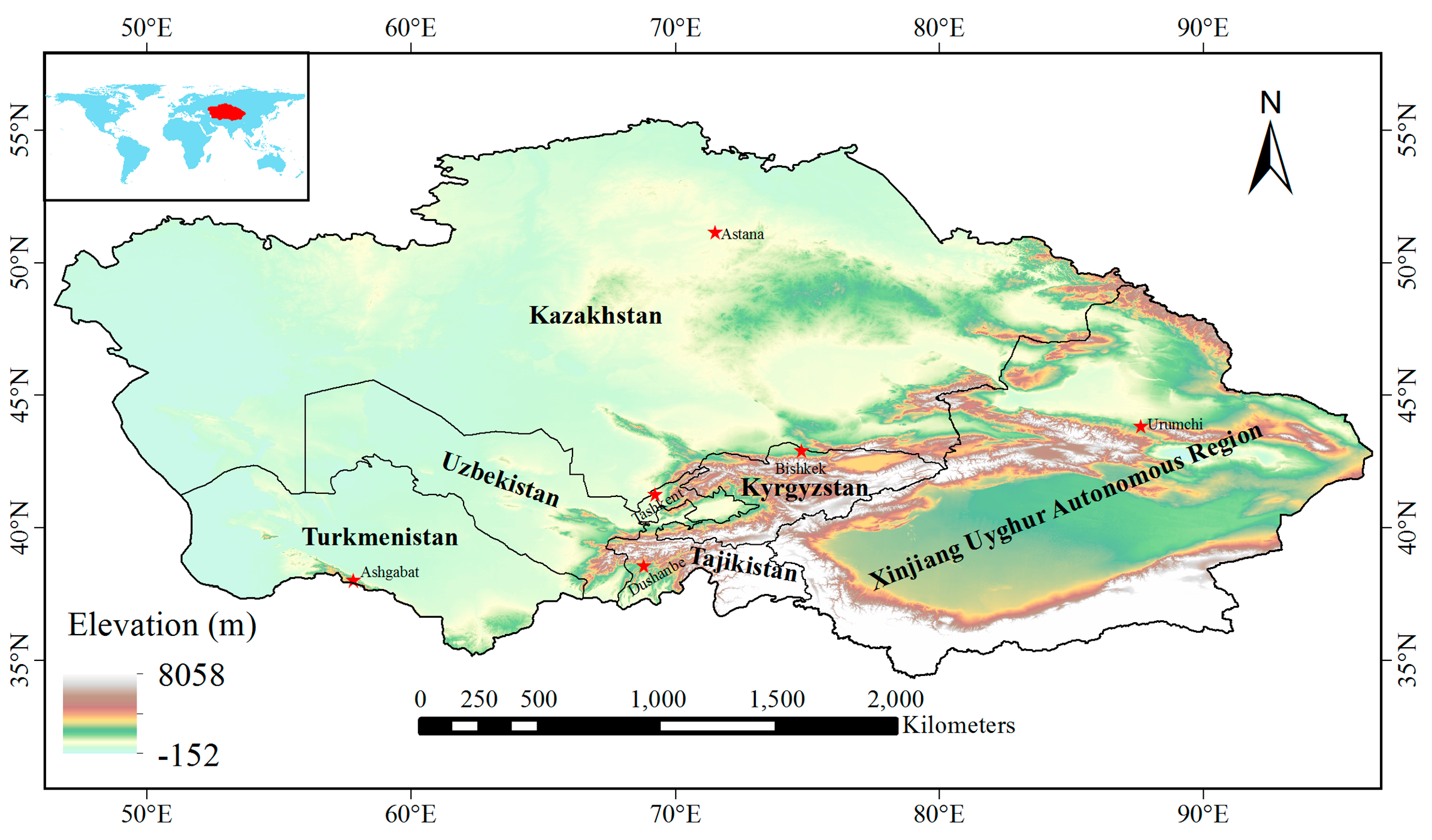
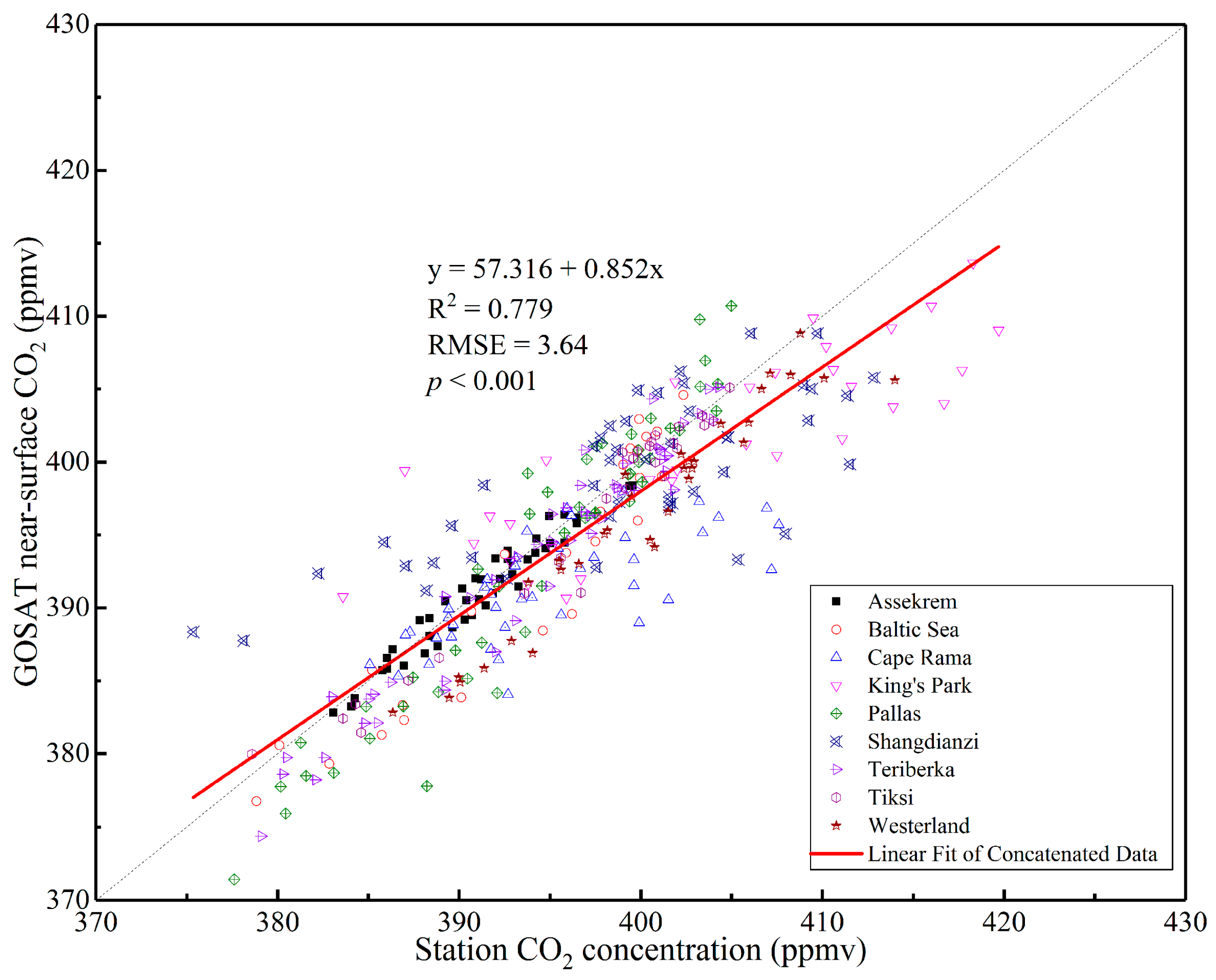
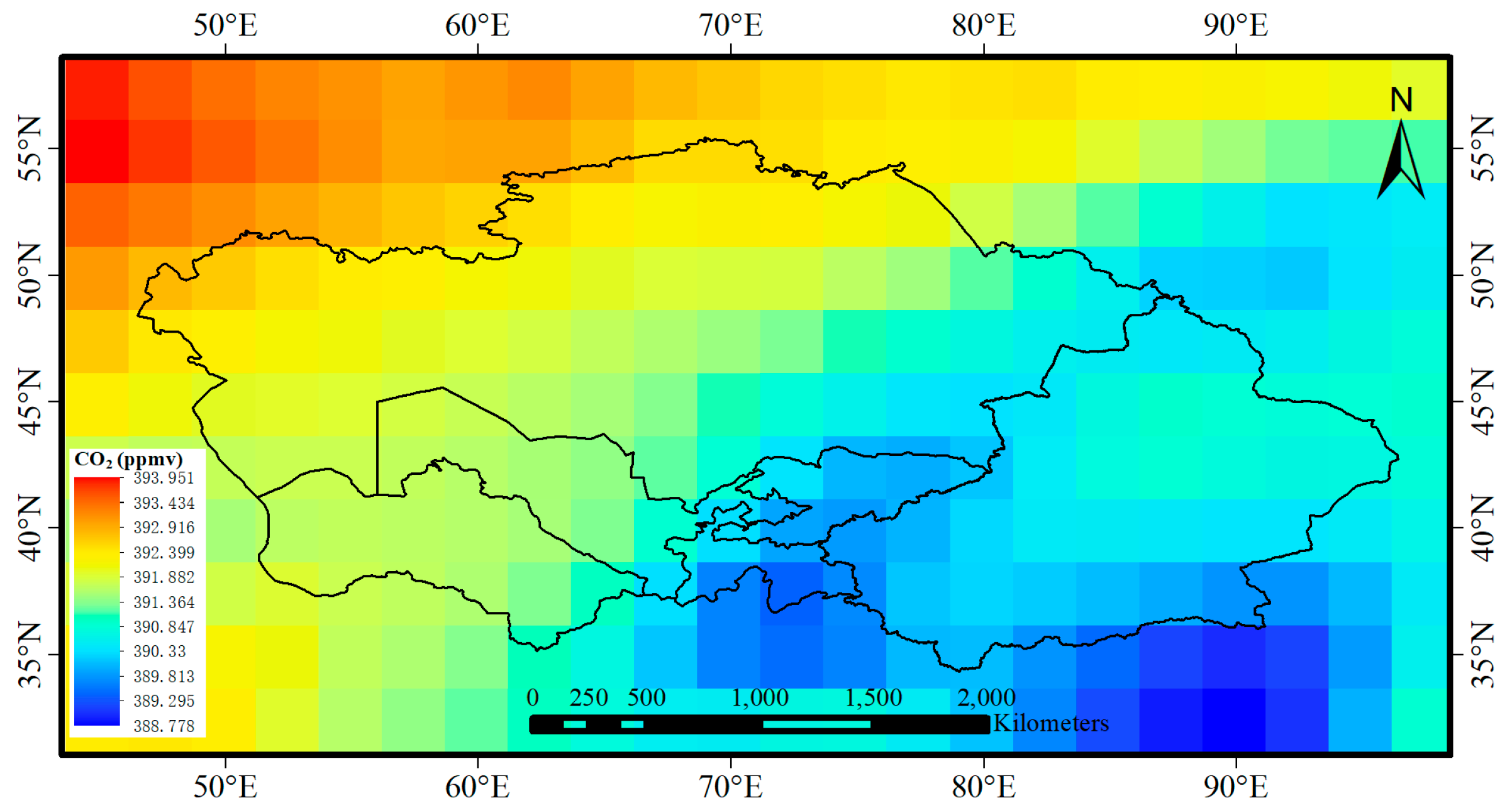
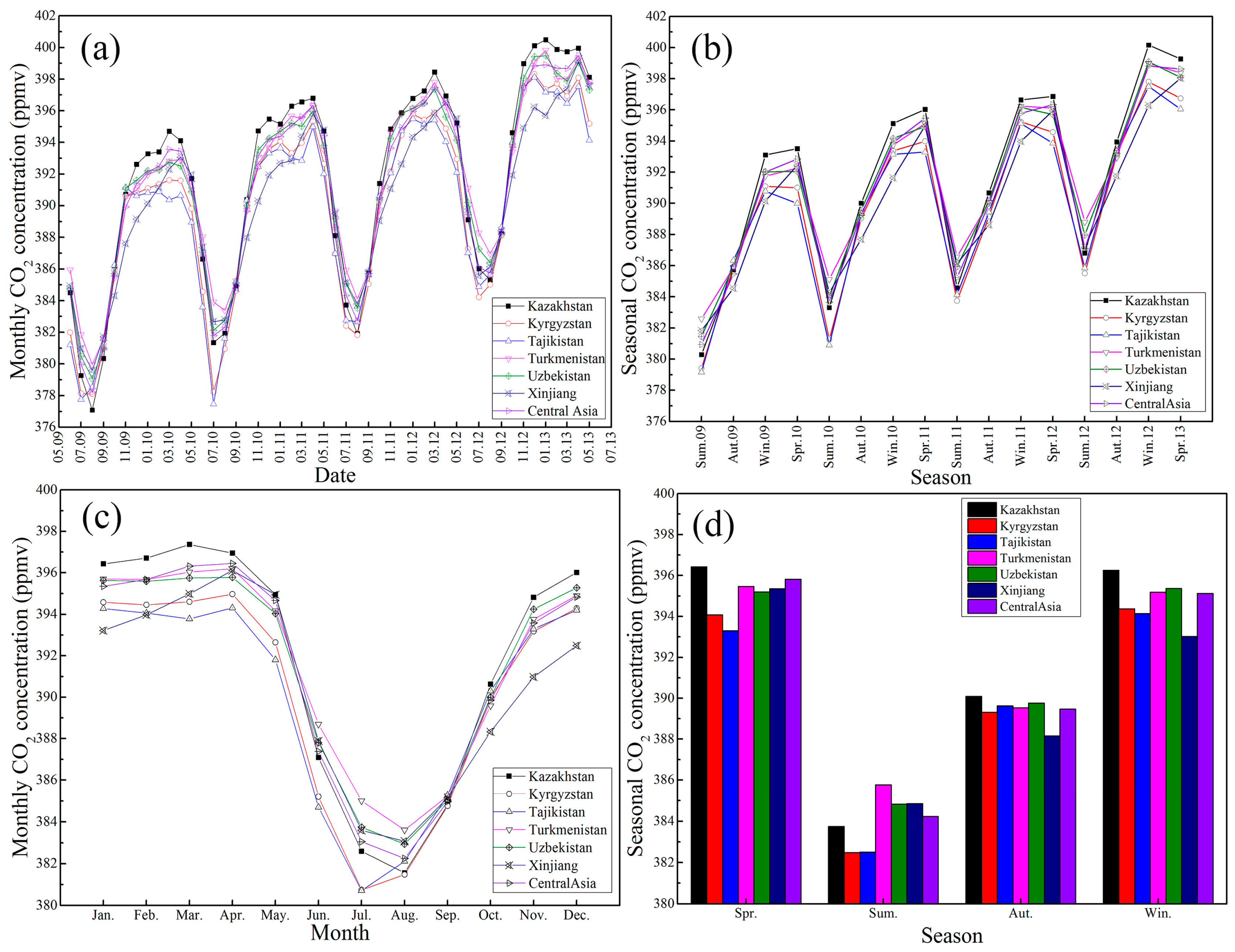
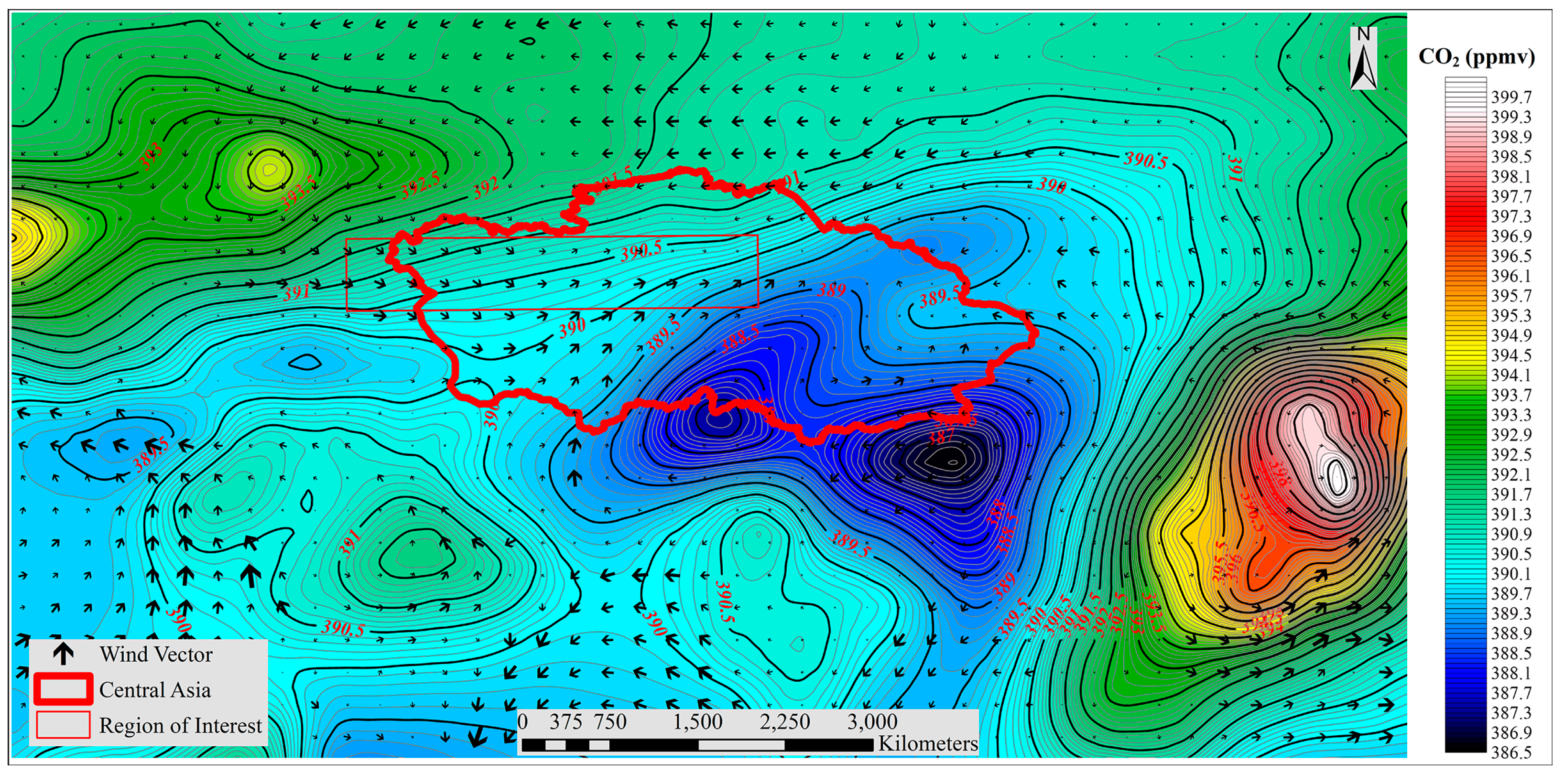
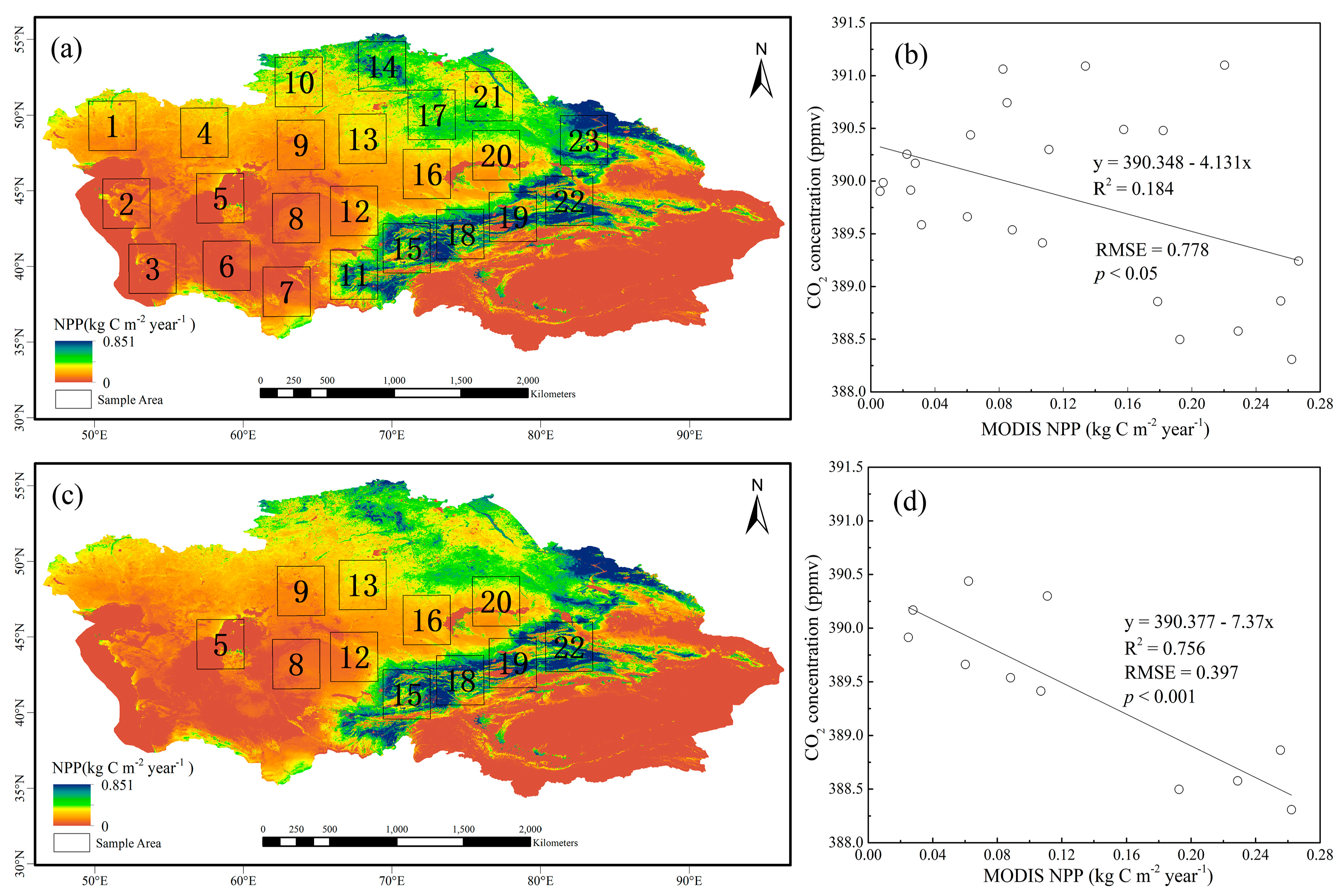
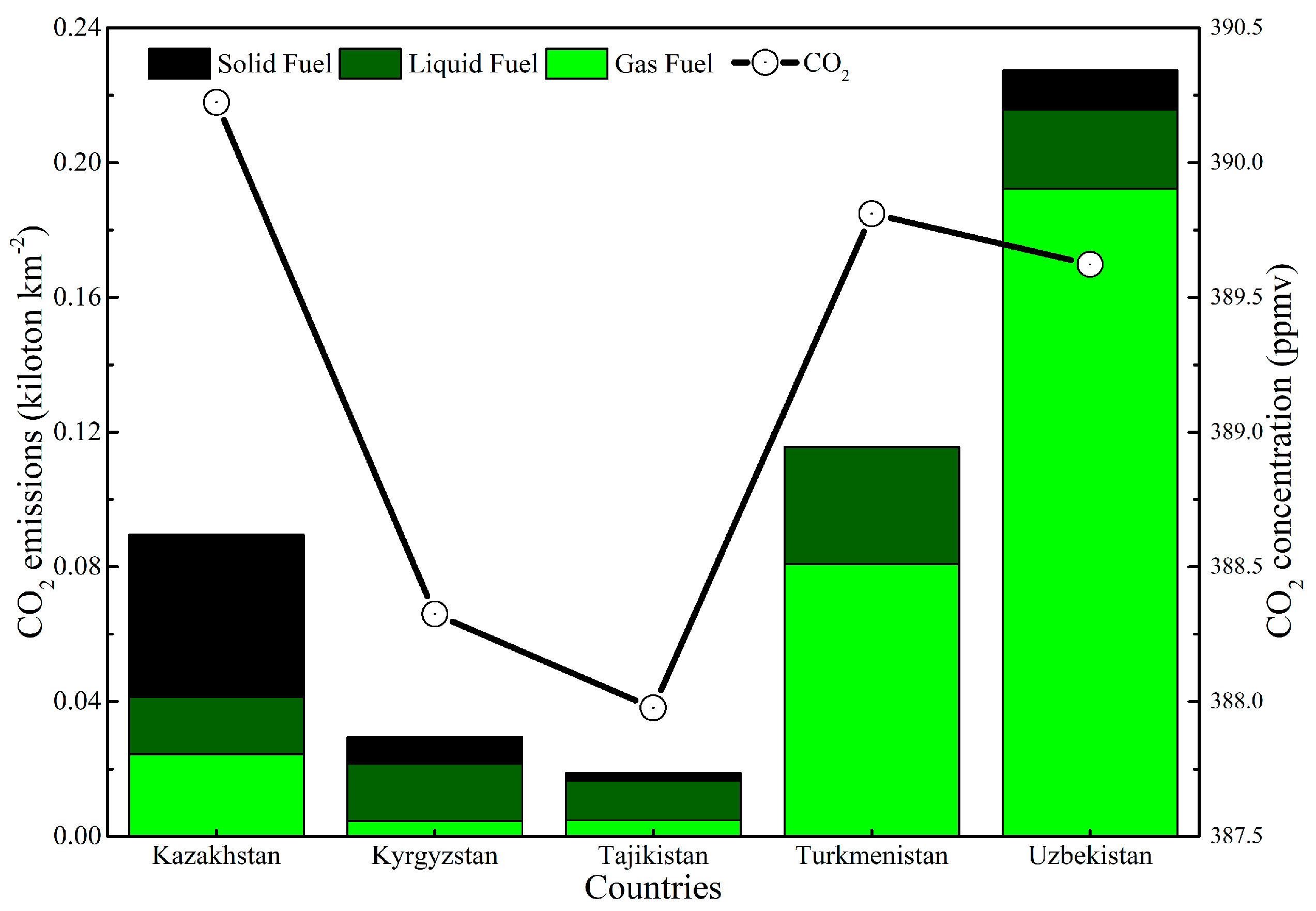

| Site Names | Ground−Base Station | Yearly Growth (ppmv/a) | Monthly Average (ppmv) | ||||||
|---|---|---|---|---|---|---|---|---|---|
| Coordinate (°) | Altitude (m) | Ground | Satellite | Deviation | Ground | Satellite | Deviation | R | |
| Assekrem | 23.27° N, 5.63° E | 2710 | 2.031 | 1.758 | 0.273 | 391.235 | 391.028 | 0.207 | 0.975 *** |
| Baltic Sea | 55.35° N, 17.22° E | 28 | 2.283 | 2.715 | −0.432 | 393.778 | 392.259 | 1.519 | 0.950 *** |
| Cape Rama | 15.08° N, 73.83° E | 60 | 2.275 | 1.307 | 0.968 | 394.960 | 391.346 | 3.614 | 0.710 *** |
| King’s Park | 22.31° N, 114.17° E | 65 | 4.433 | 1.977 | 2.456 | 403.771 | 401.340 | 2.431 | 0.852 *** |
| Pallas | 67.97° N, 24.12° E | 560 | 2.157 | 2.526 | −0.369 | 394.285 | 393.527 | 0.757 | 0.960 *** |
| Shangdianzi | 40.65° N, 117.12° E | 287 | 2.070 | 2.204 | −0.134 | 399.035 | 399.135 | −0.100 | 0.757 *** |
| Teriberka | 69.2° N, 35.1° E | 40 | 2.056 | 2.344 | −0.289 | 394.138 | 393.149 | 0.989 | 0.974 *** |
| Tiksi | 71.59° N, 128.92° E | 8 | 2.996 | 2.807 | 0.189 | 396.667 | 395.791 | 0.875 | 0.979 *** |
| Westerland | 54.93° N, 8.32° E | 12 | 4.334 | 4.940 | −0.607 | 399.994 | 396.449 | 3.545 | 0.965 *** |
| Average | 2.737 | 2.509 | 0.228 | 396.429 | 394.892 | 1.537 | 0.902 *** | ||
| Areas | Yearly Average (ppmv) | Annual Growth (ppmv/a) | Seasonal Average (ppmv) | Seasonal Fluctuation (ppmv) | |||||
|---|---|---|---|---|---|---|---|---|---|
| Spring | Summer | Autumn | Winter | Average | Maximum | Minimum | |||
| Kazakhstan | 391.663 | 2.296 | 396.422 | 383.749 | 390.091 | 396.257 | 6.336 | 12.673 | 0.165 |
| Kyrgyzstan | 390.076 | 2.145 | 394.074 | 382.478 | 389.309 | 394.371 | 5.946 | 11.596 | 0.297 |
| Tajikistan | 389.903 | 2.209 | 393.296 | 382.511 | 389.622 | 394.137 | 5.813 | 10.785 | 0.841 |
| Turkmenistan | 391.549 | 2.217 | 395.469 | 385.769 | 389.529 | 395.179 | 4.850 | 9.700 | 0.291 |
| Uzbekistan | 391.321 | 2.253 | 395.190 | 384.830 | 389.764 | 395.363 | 5.267 | 10.361 | 0.173 |
| Xinjiang | 390.394 | 2.023 | 395.347 | 384.852 | 388.153 | 393.013 | 5.248 | 10.495 | 2.334 |
| Central Asia | 391.201 | 2.207 | 395.818 | 384.230 | 389.467 | 395.127 | 5.794 | 11.588 | 0.691 |
© 2017 by the authors. Licensee MDPI, Basel, Switzerland. This article is an open access article distributed under the terms and conditions of the Creative Commons Attribution (CC BY) license (http://creativecommons.org/licenses/by/4.0/).
Share and Cite
Cao, L.; Chen, X.; Zhang, C.; Kurban, A.; Yuan, X.; Pan, T.; De Maeyer, P. The Temporal and Spatial Distributions of the Near-Surface CO2 Concentrations in Central Asia and Analysis of Their Controlling Factors. Atmosphere 2017, 8, 85. https://doi.org/10.3390/atmos8050085
Cao L, Chen X, Zhang C, Kurban A, Yuan X, Pan T, De Maeyer P. The Temporal and Spatial Distributions of the Near-Surface CO2 Concentrations in Central Asia and Analysis of Their Controlling Factors. Atmosphere. 2017; 8(5):85. https://doi.org/10.3390/atmos8050085
Chicago/Turabian StyleCao, Liangzhong, Xi Chen, Chi Zhang, Alishir Kurban, Xiuliang Yuan, Tao Pan, and Philippe De Maeyer. 2017. "The Temporal and Spatial Distributions of the Near-Surface CO2 Concentrations in Central Asia and Analysis of Their Controlling Factors" Atmosphere 8, no. 5: 85. https://doi.org/10.3390/atmos8050085








